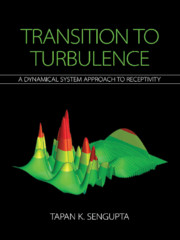Book contents
- Frontmatter
- Dedication
- Contents
- Preface
- 1 Receptivity, Instability, and Transition: A Perspective
- 2 Dynamical System Theory and Role of Equilibrium Flows
- 3 Fundamentals of Scientific Computing
- 4 Instability and Transition
- 5 Receptivity Analysis: Relation with Instability Experiments
- 6 Dynamical System Theory of Linear Receptivity
- 7 Nonlinear, Nonparallel Effects on Receptivity, Instability, and Transition
- 8 Three-Dimensional Routes of Transition to Turbulence
- 9 Receptivity to Free Stream Excitation: Theory, Computations, and Experiments
- 10 Nonlinear Receptivity Theories: Hopf Bifurcations and Proper Orthogonal Decomposition for Instability Studies
- 11 Mixed Convection Flow
- 12 Baroclinic Instability: Rayleigh–Taylor Instability
- 13 Coherent Structure Tracking in Transitional and Turbulent Flows
- 14 The Route of Transition to Turbulence: Solution of Global Nonlinear Navier–Stokes Equation
- References
4 - Instability and Transition
Published online by Cambridge University Press: 16 February 2021
- Frontmatter
- Dedication
- Contents
- Preface
- 1 Receptivity, Instability, and Transition: A Perspective
- 2 Dynamical System Theory and Role of Equilibrium Flows
- 3 Fundamentals of Scientific Computing
- 4 Instability and Transition
- 5 Receptivity Analysis: Relation with Instability Experiments
- 6 Dynamical System Theory of Linear Receptivity
- 7 Nonlinear, Nonparallel Effects on Receptivity, Instability, and Transition
- 8 Three-Dimensional Routes of Transition to Turbulence
- 9 Receptivity to Free Stream Excitation: Theory, Computations, and Experiments
- 10 Nonlinear Receptivity Theories: Hopf Bifurcations and Proper Orthogonal Decomposition for Instability Studies
- 11 Mixed Convection Flow
- 12 Baroclinic Instability: Rayleigh–Taylor Instability
- 13 Coherent Structure Tracking in Transitional and Turbulent Flows
- 14 The Route of Transition to Turbulence: Solution of Global Nonlinear Navier–Stokes Equation
- References
Summary
Introduction
In Chapter 1, we have discussed the historical development of the field of instability and receptivity. Helmholtz [177] first provided some theoretical ideas regarding hydrodynamic instability. About a decade later, the works of Reynolds [365], Rayleigh [350, 351] and Kelvin [224] produced experimental and theoretical results that laid the foundation of stability theory. According to Betchov and Criminale [28], stability is defined as the property of the flow describing its resistance to grow due to small imposed disturbances. We note that the background disturbances do not have to be small (as noted experimentally by Reynolds [365]); we will also see in this chapter that the growth noted experimentally in [405] for the zero pressure gradient boundary layer occurs over a short streamwise distance. The original question of transition to turbulence was not addressed directly in theoretical studies, as most of these were related to finding conditions for growth of background disturbances by developing the linear stability theory. This theory investigated the ability of an equilibrium state to retain its undisturbed laminar state for stability.
Instability studies began by a linear theory resulting in Rayleigh's stability equation and a corresponding theorem, [351, 353, 356], with focus on inviscid temporal instability. This theorem was based on an incorrect assumption that viscous action in fluid flow is dissipative and can be neglected to obtain a more critical instability limit. It was strange for fluid dynamicists to accept this, as researchers in other disciplines of mechanics and electrical sciences, geophysics and engineering were aware of the role of resistive instability, which can arise in fluid flow only by viscous action. Viscous action can give rise to phase shift or time delay. A basic oscillator is governed by an equation with time delay as. This is equivalent to providing anti-diffusion as noted in, with the second term destabilizing the oscillator via the time delay, τ. Despite this rudimentary observation, only when scientists failed to explain disturbance growth for zero pressure gradient boundary layer, were alternatives sought [321, 495] via the Orr–Sommerfeld equation, which has viscous diffusion included for disturbance equations.
Although we understand the importance of viscous diffusion, we begin by describing inviscid instability, as it demonstrates the logic behind Rayleigh's early works and his theorem to explain the concept of flow instability.
- Type
- Chapter
- Information
- Transition to TurbulenceA Dynamical System Approach to Receptivity, pp. 114 - 154Publisher: Cambridge University PressPrint publication year: 2021



